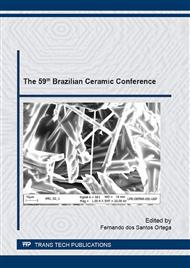p.52
p.58
p.64
p.71
p.77
p.83
p.91
p.97
p.103
Devitrification in SiO2-B2O3-Al2O3-La2O3-TiO2 Glass during the Infiltration of Ceramic Composite
Abstract:
Dental prostheses made of ceramic composites infiltrated with glasses have been used due to their biocompatibility and possibility to mimic the natural teeth. In this study, the devitrification behavior of 20SiO2-25B2O3-25Al2O3-15La2O3-15TiO2 glass during the infiltration process in a porous alumina preform was investigated. Glass frits were prepared by melting the raw materials at 1500 °C for 60 min. The glass was infiltrated into the alumina preform at 1,150 or 1,200 °C for 60 min. The specimens were characterized by X-ray diffraction analysis and scanning electron microscopy. After the infiltration, it was possible to note that the devitrification process occurred in the remaining glass (excess glass that did not infiltrate in the preform), forming mostly aluminum borate and mullite crystalline phases. However, within the infiltrated composite no devitrification was noticed in the infiltrated glass. Possible explanations for this behavior are discussed.
Info:
Periodical:
Pages:
77-82
Citation:
Online since:
November 2016
Keywords:
Price:
Сopyright:
© 2017 Trans Tech Publications Ltd. All Rights Reserved
Share:
Citation:


